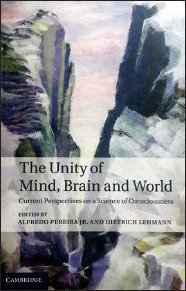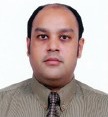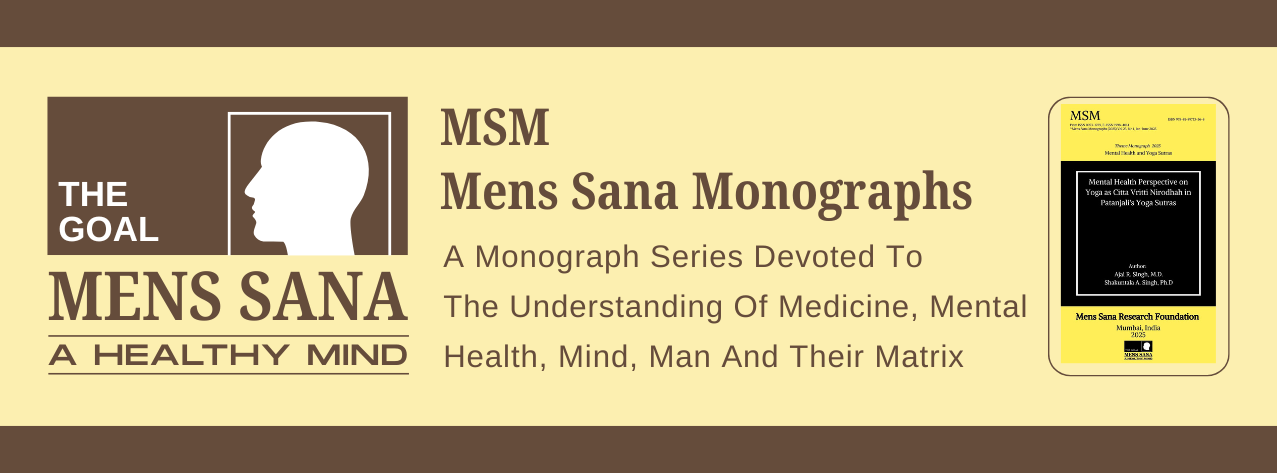Avinash De Sousa
Mens Sana Monogr. 2014 Jan-Dec; 12(1): 163–167. doi: 10.4103/0973-1229.130332
PMCID:PMC4037896

Introduction
Many books have been written regarding various aspects of the study of human consciousness. Some of them focus on the physical side utilising theories from the realms of physics while others focus on philosophy to help us determine the nuances regarding consciousness. There is a third category of book that delves into the neurobiology and neuropsychology of consciousness which often interest readers from that background. We are in an era where interdisciplinary research and collaboration are prudent if one has to understand the nature of consciousness. It is very rare to come across books that encompass authors and theories of multiple disciplines working towards explaining a single phenomenon yet in a language that readers from any discipline are able to follow what has been mentioned. Science is progressing at such a fast pace within so many disciplines that keeping pace with the same is very difficult resulting in the need for multidisciplinary books that educate one not only in the science of one’s interest, but keeps the reader abreast with the happenings in the same area but in other scientific, philosophical and non-scientific disciplines as well.
The Present Book
This book consists of 10 well-written chapters that devote themselves to cover varied aspects of the science and nature of consciousness. Though diverse, they strive for unity in encompassing brain activity and neurobiology, perception action cycles, and philosophy. They all derive inspiration from the philosophical construct of dual aspect monism which posits that the mind and the brain function derive from a common ground. They also hint upon reflexive monism that states the idea of the mind and the world reflecting each other. This book is a fine embodiment of the emerging view that the conscious mind and the functioning brain are two aspects of a complex system that interacts with the world.
The first chapter written by Bjorn Merker, an independent research scholar from Sweden, looks at neural models where one can assume the body and the world as phenomenal contents of the brains reality model. The chapter provides for an ontological framework that looks at the interactions between the brain, body and the world. The chapter is a fine blend of the psychology of heuristics or decision making, motivation from a neurocognitive perspective and puts forth a dual purpose neural model that works from both an orienting and a decision domain. It is a well-written chapter that blends cognitive, phenomenal, and neural theories to put forward a theory of its own.
The second chapter written by three authors from the University of California, USA put forward the neuroanatomical loci of what constitutes conscious states while also writing about mental processes involved in consciousness. They follow a brutally reductionist approach while they adhere to three theories viz. supramodular interaction theory, the monogenesis hypothesis, and consciousness associated with a limited direct cognitive control. They also propose a new hypothesis called the buffer of perception and action interface (BPAI), which is worth a read.
The third chapter written by Cottam and Ranson, two Belgian researchers speak of biosemiotic view of consciousness. This is a theory based on biosemiotics, which explains signs in living process and life systems that demonstrate consciousness while they also take in various aspects of systems theory and systems hierarchy and apply it to explain conscious phenomena. It is a new concept and one that must be read when considering the direct relations between awareness and consciousness, birationality, ecosystems, and consciousness, as well as energy aspects of consciousness. Though biological and systems theory based, the chapter is an essential addition to various views of conscious processes.
The fourth chapter, written by Wolfgang Baer, a professor of information systems and physics, tries to interpret the conscious aspects of physical processes and looks at the metaphysics of quantum theories when applied to consciousness. The chapter, though lucidly written, is quite lengthy and involves various wave particle theories as well as other emerging theories of quantum physics while attempting to maintain a neurophysiological approach. It is a feast for readers interested in physical aspects of consciousness.
The fifth chapter, written by Ram Vimal, a professor from the Vision Research Institute working both in India and in the United States, speaks about the dual aspect monism framework of consciousness. It moves from a neural framework to a self-awareness one and works on the premise that in a neural framework, when talking of biological states, micro-potentialities can be transformed into macro-actualities. It also talks about the phenomenon of whether the existence of dual aspect entity may exist after death.
The sixth chapter, written by Dietrich Lehmann, a Swiss neurophysiologist, speaks about consciousness and its emergence in human beings as a species. It then looks at altering states of consciousness and localising consciousness in the brain while teasing the debate of the interactions between consciousness and free will. It puts forward a theory of brain microstates and electric fields positing a framework of brain microstates and emotions, mentation, information and syntax. It mentions about the atoms and molecules of thought and put microstates as the building blocks for consciousness, which is an emerging viewpoint in consciousness generation today.
The seventh chapter, written by Arnold Trehub, a psychologist takes a viewpoint on sensory perceptual awareness and consciousness. It amalgamates the psychology of three-dimensional and two-dimensional imaging, visual processes, shape perception as well as visuospatial awareness, and proposes a specialised system in the brain called the retinoid system that may explain consciousness.
The eighth chapter, written by Bernhard Mitterauer, a professor of neuropsychiatry at the University of Salzburg, speaks about the emerging theory of glial neuronal units in the study of cellular generation of consciousness. It introduces concepts like the glial synaptic unit and proemial synapse (proemial is glial neuronal synapse unit made up of presynaptic and post-synaptic neuron with their glial cells). While speaking about astrocyte function, it also looks at astrocyte syncytium and the various types of connexion proteins (adherence proteins of glial cells) within the syncytium and their role in the generation of consciousness. Thus micro-consciousness or cellular aspects of consciousness are well defined via this chapter.
The ninth chapter, written by Leonid Perlovsky, a research scholar in the United States, looks at the interface of the cognitive model of language and conscious processes. It encompasses linguistics, theory of the cognitive aspects of language, semantics and creativity while blending these with music cognition, language prosody, and formal logic trying to hypothesise a neurocognitive linguistic theory of consciousness.
The final (tenth) chapter, written by Alfredo Periera Jr. from Sao Paulo Brasil, speaks about Triple Aspect Monism (TAM) physical-chemical and biological aspects of conscious processes and theory. While consciousness continuously unfolds into the real world and spreads across various realms, it argues that the TAM theory is one that will serve to unify and explain various forces of consciousness. It takes a relook at the Global Workspace Model of consciousness as well.
Certain other critical comments
The book has been edited by two renowned authorities in the field of consciousness, and merits a read by every follower, researcher, and scientific explorer of the realms of consciousness. It encompasses various disciplines put under one roof in one book; but, while sumptuous, may also lead to indigestion if not read with pause and reflection. It is not a book that one could read on a flight or after a day’s hard work while in bed, but needs rapt scientific attention and cross referencing and making notes to further understand the concepts mentioned. The chapters on glial synaptic units and physical aspects of consciousness have mathematical symbols and complicated representations that may dissuade the reader to walk those shores and could have been better without those notation, though one must also argue that explanation may not be possible fully without them. With a little patience, I believe most readers will be able to tide through them. The book should have had a critical commentary after each chapter and this could have added a scientific enquiry and debate aspect to the book. The book, though consisting of ten diverse chapters, has no chapter that tries to synthesise all the information in the book. Also, the individual chapters fail to give adequate flowcharts or summaries of all information in the book. Nevertheless, the book is a must on the shelf of every consciousness researcher.
Who Should Read it
While this book is not meant for young and novice consciousness researchers who require terminology description and basic concept clarification along with in-depth discussions and extensive reference materials, it will certainly suit the needs of serious consciousness researchers who are already aware of the basics and want to further explore the realm. Very importantly, this book is the springboard from which the advanced reader can take a leap into newer areas of consciousness research. This book is strongly recommended to all consciousness scientists and researchers while some psychiatrists, physicists, and philosophers with an interest in the area may find it useful as well. This is a phenomenal piece of scientific endeavour and good work put in by all the authors and the editors. It needs to be savoured by those who are worthy enough to relish its taste.
Book Rating
I will rate the book****.
[* Poor; ** Fair; *** Good; **** Very Good; **** Excellent]
About the Reviewer

Avinash De Sousa is a consultant psychiatrist and psychotherapist with a private practice in Mumbai. He is an avid reader and has over 230 publications in national and international journals. His main areas of interest are alcohol dependence, consciousness, brain stimulation, neurobiology and child and adolescent psychiatry. He teaches psychiatry, child psychology and psychotherapy at over 18 institutions as a visiting faculty. He is also the founder trustee of De Sousa Foundation – a charitable trust aimed at spreading mental health awareness, training, and education across all sectors. He is one of the few psychiatrists who, in addition to a post-graduation in psychiatry, has earned a Masters in Counselling and Psychotherapy, an MBA in Human Resource Development, a Masters in Religion and Philosophy, an M. Phil in Applied Psychology, and a doctorate in Clinical Psychology from the UK
Footnotes
Conflict of interest: None declared.
Declaration
This is my original unpublished work and has not been submitted for publication elsewhere.
CITATION: De Sousa A. MSM Book Review: The Unity of Mind, Brain and World (Current Perspectives on a Science of Consciousness). Mens Sana Monogr 2014;12:163-7.

